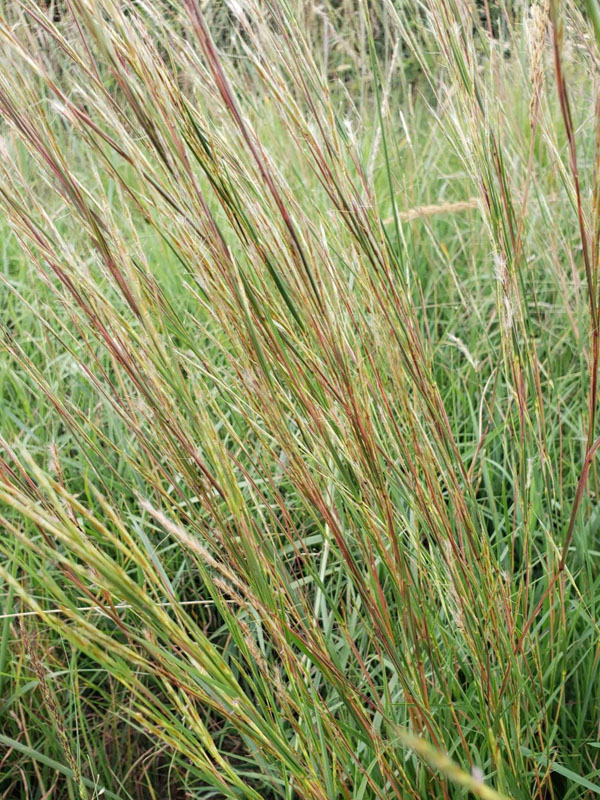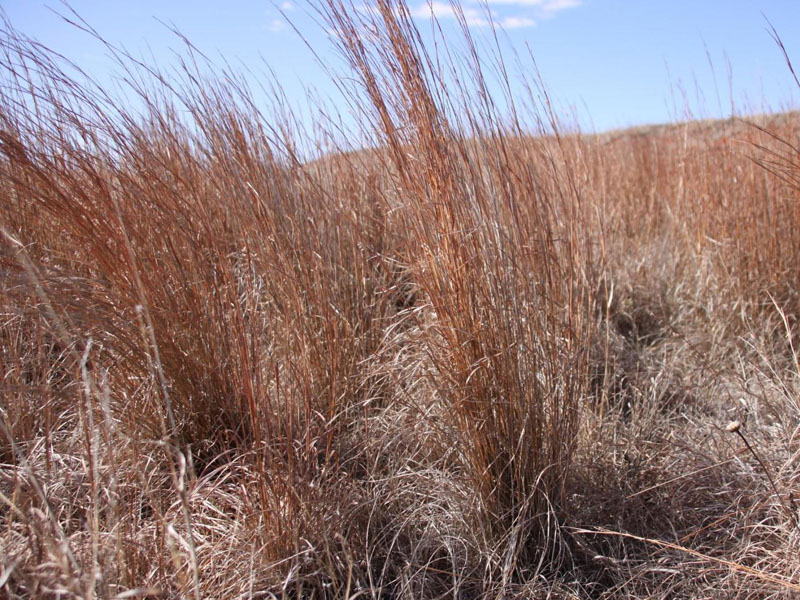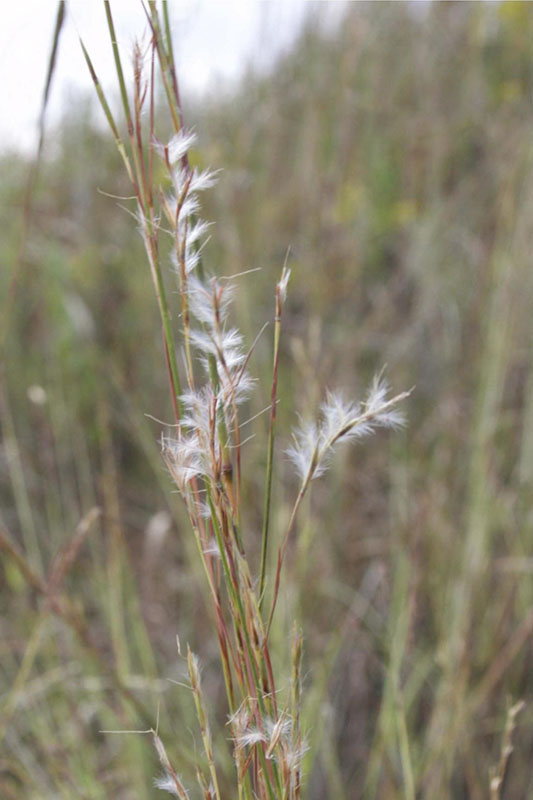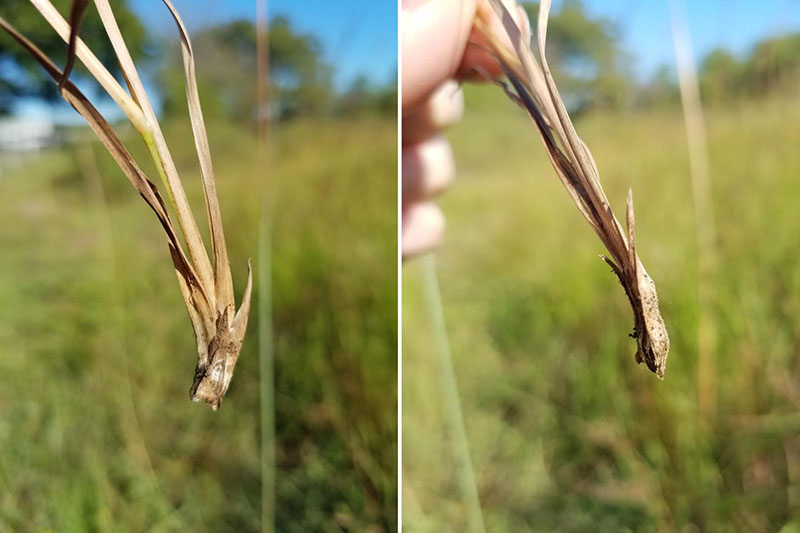Little Bluestem
| Plant Profile | |
|---|---|
| FYUSE 3D Image |
Common Name: Little Bluestem Species Name: Schizachyrium scoparium Plant Type: Grasses & Grass-like Family Name: Poaceae, Grass Family Tribe: Andropogoneae, Bluestem Tribe |
Examples of Little BluestemSchizachyrium scoparium
| Plant Facts | |
|---|---|
| Origin | Native |
| Duration | Perennial |
| Season | Warm |
| Distribution in the U.S. | Throughout the country except along the Pacific Coast states and parts of the Great Basin |
| Distribution in Oklahoma | Throughout the state |
ID Characteristics
- Field Identification Characteristics
Vegetative
- Foliage a blue-green color when growing and reddish when dormant
- Stems with noticeable nodes; flattened at bases
- Bunchgrass
Floral
- Seed heads have thin, feathery appearance
- Only 1 branch in seed head with leaf below each
- Leaf and Stem Characteristics
- Plant Height: 45-130 centimeters
- Ligule Type: Ciliate membrane
- Sheath: Glabrous or villous or pilose
- Leaves: Basal
- Floral Characteristics
- Inflorescence Type: Rame
- Florets Per Spikelet: 2
- Glumes: Equal
| Habitat/Ecology | |
|---|---|
| Soil Type | Well-drained sand, loam and clay |
| Habitat | Tall and mixed-grass prairies |
| Successional Stage | Mid to late |
| Uses/Management | |
|---|---|
| Grazing | Used in the Great Plains by bison (where reintroduced), particularly either areas moderately grazed by prairie dogs or frequently burned. Grazed areas preferred when unburned rather than burned. Burned areas preferred when more frequently burned. During spring the preference was highest, showing three times more use on burned areas than unburned. Also an important source of forage for domestic livestock. Generally lower production and nutrition than associated grasses (sand bluestem, crested wheatgrass, prairie sandreed, side-oats grama and blue grama), but production remains constant from year to year except in severe drought. Protein content only about half that of blue grama at the same stages. Important component of upland hay; good quality if cut early (early to mid-summer before nutritive quality decreases). Early growth is highly palatable to most livestock. Seed stalks are mostly avoided by livestock, but heavy use of immature seed heads seen in Texas. Animals continue to graze basal leaves until plants mature. Plants are grazed in fall and winter after more palatable plants have been used. Further south, use may be year-round, not only seasonal; mild climate allows plant to stay green throughout the year. In December and January, some new shoots grow around the edges of Little Bluestem bunches and in the interior. As it matures, cattle select green leaves from the interior. Stage of maturity greatly impacts nutritional value. Medium- to high-quality forage in spring and summer, declining by mid-summer. Protein content peaks in May to June and declines over the summer, ranging from 3-11%. Burn plots have shown higher protein, calcium, and phosphorus contents and lower fiber. In tallgrass prairie it is an increaser; farther west it is considered a decreaser. In Kansas, dense stands were maintained with continuous, moderate grazing leaving 40-60% of the current growth ungrazed. Intensive early stocking (twice the recommended stocking density) for the 1st half of the growing season and no grazing during the 2nd half allows forage to regrow and replenish carbohydrate reserves. Overgrazing can cause increase of shrubs and cool season grasses. Early cattlemen burned on a rotation so cattle always had access to recently burned Little Bluestem; still used to increase warm-season grass in warm-season pastures or rangelands infested with undesirable plants. Late spring headfires recommended over backfires to produce more forage. |
| Wildlife | Highly palatable for many species of wildlife in its early stages of growth. In the southern United States, it may be consumed by animals year-round. It has relatively high protein and phosphorus content when compared with other pasture grasses, which can significantly increase in areas where burning has occurred. Seeds are valued by lesser prairie chicken, songbirds and sharp-tailed grouse. Northern bobwhites, ring-necked pheasants, and quail use Little Bluestem for forage in areas where it grows with sideoats grama. Also important to the red-headed woodpecker, Baltimore oriole, eastern kingbird, vesper sparrow, field sparrow, lark sparrow, brown thrasher, American goldfinch and brown-headed cowbird. Little Bluestem communities are very important to bison grazing, particularly in areas of burning, which results in more usable biomass. Good protective cover for small mammals, small nongame birds, and upland game birds; fair protective cover for waterfowl. Important nesting cover for bobwhite quail, northern bobwhites, lesser prairie chickens, Montezuma quail, sharp-tailed grouse and other upland game birds. Attracts a number of insects including caterpillars, leaf beetles, jewel beetles, planthoppers, grasshoppers, aphids, leafhoppers and scales. |
Topics:





